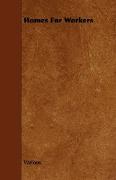Homes for Workers
BücherAngebote / Angebote:
FOREWORD, THE most pressing problem facing the people of the United States, for which no final solution has as yet been demonstrated, is that of housing low income groups. How great is the need The United States Senate answers, reporting that 13, 200, 000 new dwelling units must be built by 1945. That requires an average construction of 1, 3 20, 000 new houses and apartments each year for the next 10 years. What is being done The Bureau of Labor Statistics says that in 257 typical cities surveyed only 22, 063 new homes were built in 1934. In the more normal year of 1925 only 491, 222 homes were completed in these cities. Therefore, even if the private construction industry comes back to pre-depression full strength, it will be able to meet less than half of the need. What will happen to wage earners Even if this enormous deficit in all kinds of housing were made up, past experience suggests that unless some new techniques are developed little or none of the new construction will be of the kind which low-income families can afford. Unless we very quickly change our habits of thought and action about housing, workers will have to remain content with the cast-off, frequently worn out, almost always deficient houses discarded by other sections of our population. Homes for Workers is a simple statement of the housing situation which confronts American workers and their Governments - Federal, State and Municipal, It has been prepared as a joint project by the Public Works Administration and by the Works Progress Administration, for use in adult education classes conducted by the Educational Division of WPA. Public Works Administrator Harold L. Ickes, under whose direction the Federal Government has been constructing 25, 000 dwelling units in 51 projects located in 36 cities as a demonstration of low-rent housing possibilities, says that the future housing program is a matter for the cities to solve. The cities are what their citizens make them and their citizens are, in large measure, the workers. Do the workers want low-rent housing H. A. GRAY, Director of Housing. CONTENTS Chapter I. Is There a Housing Problem , , ---- 11. What Makes a Home --------------.---- 111. How Good are American Homes- ------- IV. What are the Effects of Bad Housing-- - - V. What is the Need for New Housing-- - --- VI. What is the Cost of Housing Money.. - - - - VII. What is the Cost of Housing Development- VIII. Row ReaI Estate Taxes Affect Housing---- IX. How Could We Have Better Housing- - - - X. What is Slum Clearance-- ------ - ------- XI. How Does the Government Help --------- XII. What Can Local Governments Do -----l XIII. What Have Workers Done -------------- XXV. What Can Workers Do ----- - --- -------- XV. The Future of Government Housing- - -, -- XVI. The Future of Private Housing ----------- XVII. Conclusion --------------- -------------- Page 1 IS THERE A HOUSING PROBLEM EVERYBODY talks about housing these days. The dictionary says that housing means that which gives shelter, but the word, as most people use it, includes low cost. Although most people mean, by this term, housing of which the construction cost is cheap, this is not the proper definition. Cheap construction is only one part of low-cost housing. The proper definition would be housing that is provided at low cost to the tenant. Usually when you read about housing, the writer refers to homes for low wage earners. The reason that housing is so much talked about is that there seems to be a problem of providing good houses at prices which wage earners can pay. Three kinds of people are interested in low-cost housing the people who live in it, the people who make money from providing it, and the people who think something should be done about it...
Folgt in ca. 10 Arbeitstagen




